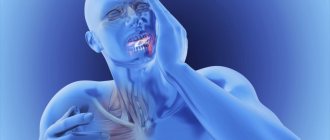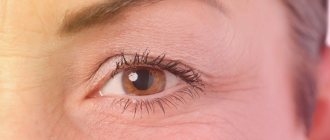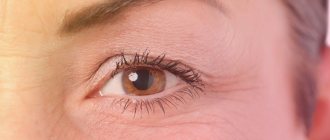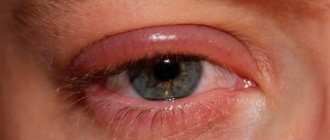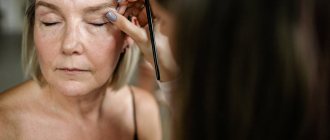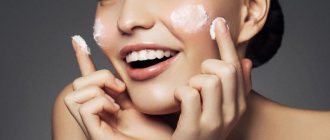What it is?
Ptosis is a general term that means drooping of an organ or part of the body. The eyebrows, corners of the lips, eyelids, chest, kidneys, etc. can move downwards. Depending on the cause of the drooping, the following can be distinguished:
- ptosis as a consequence of injury, disease or as a congenital pathology;
- gravitational ptosis caused by the aging process and the force of gravity.
The fundamental difference is that in the first case we are talking about a kind of disease that is not very common, and in the second it is about a natural and inevitable phenomenon to which everyone without exception is susceptible. Thus, the word “ptosis” usually means gravitational ptosis or, simply put, sagging skin.
Prevention
The aging process cannot be stopped, but the manifestations of gravitational ptosis can be postponed to a later date. To do this, you need to start taking care of your skin and facial muscles at a young age.
Preventive measures will help:
- Proper nutrition: include as many vegetables and fruits in the menu as possible. Porridge, nuts, and whole grain bread have a beneficial effect on muscle tone. Reduce consumption of salt, sugar, and avoid fast food products.
- Daily physical activity, walking.
- Regulate water consumption. The skin needs 2 liters of fluid daily. It is useful to drink the first glass of water immediately after waking up.
- Do facial massage and gymnastics daily. Nourish your skin with masks once a week.
- It is useful to rub your face along the massage lines with ice cubes.
After 30 years, the body begins to urgently need to replenish its reserves of vitamins. You can purchase special complexes that include 6 essential vitamins:
- E (tocopherol) - antioxidant, inhibits the aging process, increases the amount of estrogen;
- C - strengthens the immune system;
- A - is responsible for the condition of the skin; a lack of vitamin leads to peeling of the dermis, the formation of cracks, and sagging;
- group B - ensures normal functioning of the nervous system, affects the condition of hair and eyelids;
- H - accelerates the production of elastin, participates in metabolic processes;
- D - “sun vitamin”, is involved in cell renewal, promotes the absorption of magnesium and calcium.
Minerals will help slow down biological aging. They regulate the water-salt balance in the body, participate in hematopoiesis, and are responsible for the condition of muscle tissue. Minerals are not synthesized in the body.
It is necessary to include in your diet foods containing vital macroelements:
- potassium: fresh fruits, dried apricots, liver, greens;
- sodium: cheese, sea fish, beets, garlic;
- calcium: cottage cheese, vegetables, honey, fish;
- magnesium: legumes, cucumbers, buckwheat, dried fruits.
How and why?
Of course, not only age-related changes lead to the body becoming flabby and its contours blurring. Common causes of ptosis are:
- sudden weight loss;
- pregnancy and breastfeeding;
- minimal physical activity;
- hormonal imbalances.
In all cases, the mechanism of development of ptosis is approximately the same. Elastin and collagen fibers, which are located under the top layer of skin, stretch, become thinner and can no longer play the role of reinforcing material. And if the muscles also weaken, this aggravates the situation. Under the influence of gravity, the skin sags, forming unsightly folds and furrows.
Reasons and factors
Factors that can lead to such changes include not only weight fluctuations and age. Some people are predisposed to drooping soft tissues of the face due to certain anatomical features.
Possible causes are also often cited:
- genetics,
- deficiency of collagen and elastin,
- problems with lymph flow,
- water balance disturbances,
- weakening of the muscular-ligamentous apparatus,
- lack of certain substances in the body (for example, retinol, carotene, vitamin C, zinc, iron).
Today, there are various cosmetic procedures that can help minimize the effects of gravitational ptosis and prevent prolapse of soft tissues.
The most problematic places
Ptosis can affect almost any part of your body, but the most vulnerable are the eyelids, face, chest, neck, and inner surface of the forearms. These are precisely the zones that most eloquently indicate a person’s age and shape his appearance. Therefore, the doctor at our clinic uses many techniques that can stop premature aging and sagging skin. These techniques can be either invasive or non-invasive.
Our specialist looks at which area requires correction and how serious the problem is, and then chooses the appropriate technique. In some cases, to eliminate a defect it is necessary to perform a set of various procedures. Let's look at the most popular options.
"Tired" type of aging
The first age-related changes appear on the face. In the morning, after a full rest, the face looks fresh, and in the evening it looks sad and tired: bags and dark circles appear under the eyes, the nasolacrimal and nasolabial furrows begin to appear, the corners of the mouth droop sadly. The shape of the face remains unchanged, although its youthful roundness has already disappeared.
The “tired” type of aging is more pronounced in women of normal or thin build, middle age with an oval or diamond-shaped face, with normal skin in youth and moderately dry skin in middle age, with average expression of the subcutaneous fat and muscle layer.
This type of aging is characterized by dryness, decreased skin turgor and elasticity. Dull, uneven, grayish complexion, swelling and pastiness are caused by impaired lymphatic drainage and blood supply, which lead to tissue hypoxia. Initial lipoatrophy (decreased thickness of the subcutaneous fat layer) and decreased tone of facial muscles leads to a decrease in the fullness of the soft tissues of the face. Age-related tissue decline has already begun, but permanent wrinkles have not yet formed.
Rejuvenation techniques for the “tired” type of aging
The “tired” of age-related changes responds gratefully to any care, so various cosmetic procedures come first in terms of efficiency and rationality, with plastic surgery joining later.
1) Cosmetic procedures aimed at improving microcirculation, improving the tone of facial muscles, stimulating the production of collagen, elastin, hyaluronic acid and restoring facial volumes:
- Competent skin care for the face and neck at home
- A visit to a cosmetologist for professional skin care for the face and neck, which will include:
- non-invasive methods (facial cleansing, massage, moisturizing, nourishing and modeling masks, superficial chemical peeling of the skin);
- physiotherapeutic methods (myostimulation, microcurrents and ultrasound therapy);
- invasive methods (biorevitalization, bioreinforcement and contouring with hyaluronic acid gels, mesotherapy with homeopathic and vitamin cocktails).
2) Surgical technique
- contour plastic surgery of the face using one’s own adipose tissue – lipofilling – to improve the quality of the skin and restore facial volumes lost due to lipoatrophy.
Upper eyelid ptosis
It all starts with the appearance of folds on the eyelids, which are visible only when the eyes are open. Later, these folds become more pronounced and descend lower to the eyelashes. As a result, the “excess” skin of the eyelids begins to hang over the eyes, visually narrowing them.
You can solve this problem surgically - the most effective, reliable and safe way. The operation involves removing a section of the skin of the eyelid, due to which the folds appear to be smoothed out (upper eyelid surgery). Nowadays, eyelid lift is becoming an increasingly popular rejuvenation procedure.
What does cosmetology offer for facial rejuvenation?
Now that you have understood the basics of dental pathologies that affect the appearance of the lower third of the face, let's look at the main range of cosmetic procedures that are aimed at maintaining facial tissue and skin in tone and which have an externally rejuvenating effect.
Let us immediately make a reservation that most of these procedures do not have a permanent effect, and in order to always look young (not only in the soul, but also in appearance), these rejuvenation procedures must be repeated regularly.
So, modern rejuvenation methods guard your beauty
Facial ptosis
Patients most often come to us with facial skin ptosis. Time and gravity inexorably distort features, resulting in wrinkles, tear furrows, dark circles or bags under the eyes, “bulldog” cheeks and other changes. The face itself seems to blur, losing its original shape.
The possibilities of modern cosmetology and plastic surgery are so wide that they can successfully combat the manifestations of ptosis. The specialists of our clinic have extensive experience in this fight and carry it out in several directions:
1. Injections . The essence of the method is that the substance used for correction is injected under the skin using an injection. These substances can be different and, accordingly, give different effects. So, our doctor conducts:
- a course of injections to smooth out wrinkles and folds (Botox);
- injections of drugs based on hyaluronic acid to synthesize collagen and increase skin elasticity (contouring);
- injection of the patient's own adipose tissue under the skin to replenish volume (lipofilling).
2. Thread lifting . This technique allows you to tighten sagging skin using special threads that are fixed in the subcutaneous tissue. In essence, they perform the function of reinforcement, preserving the contours of the face and preventing the formation of folds. The threads can be absorbable or non-absorbable, smooth or notched, etc. The doctor implants them under the skin through tiny punctures using a special needle or cannula.
3. Hardware procedures . Currently, this is perhaps the most gentle and effective way to rejuvenate facial skin. The impact can be provided using radio waves, laser, microcurrent, ultrasound, etc. In our clinic you can use the following procedures:
- fractional photothermolysis;
- RF lifting;
- laser resurfacing.
4. Plastic surgery . In case of significant sagging skin and in cases where other methods are ineffective, our specialists can offer a radical approach - the help of a surgeon.
External changes in the lower third of the face
Asymmetry - how to correct the situation?
Most radical and “global” rejuvenation treatments affect the lower third of the face. Why? The answer is quite simple: it is in the lower third of the face that the dentofacial system is concentrated, which, for a number of reasons, undergoes significant changes, leading to changes in the surrounding facial tissues. The process, if described in simple words, looks like this: the bone atrophies, the tissue follows the bone. Visually, this violates the aesthetics of the face, causing facial asymmetry.
The presence of bite pathologies can also affect facial aesthetics
.
Let's look at it in order:
First, as it happens, one tooth is lost
.
Missing one tooth. Starting factor #1
If only one tooth is missing, then at first it may not be very noticeable; the contour of the lips will change slightly, as the lip will begin to “sink” into the place of the missing tooth.
But there is one important point: the bone tissue in the absence of a tooth will begin to dissolve.
What does this mean from the point of view of violation of facial aesthetics:
- The necks of neighboring teeth will gradually begin to become exposed and their loss may occur,
- in this case, the lip will sink even more, affecting the neighboring muscles, and small vertical folds may appear above the lip.
The loss of one tooth is not critical, but you need to know that as a result of the loss of a tooth in the chewing region, the load will begin to be redistributed to other teeth, including the anterior frontal region. And the additional, unplanned by Nature, load on the teeth leads to their abrasion
. When two or more teeth are lost, the processes of distributing the load on adjacent teeth begin to occur more actively.
So, the next factor is tooth wear.
Tooth wear and bruxism. System factor #2
Now let's look at what happens with tooth wear and bruxism.
At its core, tooth wear involves abrasion of the tooth tissue. With pathological abrasion and bruxism, this process occurs many times faster, the crown part of the tooth decreases, and again the height of the lower third of the face decreases.
When teeth wear down, changes occur in the temporomandibular joint, just as in the absence of teeth.
What aesthetic defects
faces appear when erased:
- the lower jaw gradually begins to rise upward,
- the distance between the tip of the nose and the chin decreases,
- nasolabial folds increase,
- Vertical wrinkles appear around the lips.
The next factor in external aesthetic changes in the face is malocclusion
. This is one of the most common problems.
Malocclusion. Global factor #3
If the teeth are not positioned visually, it may:
- the tip of the chin moves,
- a second fold appears under the chin,
- “cluttered” chewing teeth can externally “round” the jaw line at their location, that is, the jaw line from the chin towards the ear will not be “chiseled”.
- also, if the teeth are incorrectly positioned, the lower jaw can protrude forward or, on the contrary, move backward - outwardly such a chin looks “sloping”, as if the neck immediately begins from the chin.
Bite pathology very often “adds” a sufficient number of unplanned wrinkles
.
From an aesthetics point of view, a problem arises that very often begins to be solved with the help of cosmetic procedures: Let’s look at what it looks like using specific examples of only two malocclusion pathologies (and there are many more of them).
Did you know that, for example, the feature of the distal occlusion
is there an imbalance in jaw development?
The teeth of the upper jaw quickly begin to protrude above the lower ones, while the lower jaw lags behind in development, as a result of which the chin appears small and looks unnatural. From an aesthetic point of view, this leads to the appearance of wrinkles
in the lip area. And the face itself becomes unattractive.
And in case of deep bite
there is a significant overlap of the lower dentition with the upper teeth and, as a consequence of such contact, there is increased wear of the teeth, which we talked about earlier in factor #2, which further leads to a reduction in the lower third of the face.
We started the story with factor #1 - the loss of one tooth. But the most serious problems of facial aesthetics begin with the loss of several teeth, when bone tissue atrophy begins to develop, entailing, in fact, both bone atrophy and changes in the structure of soft tissues.
So - edentia. Global factor #4
Adentia can be either complete or partial. With complete edentia, there is a complete absence of teeth on one or both jaws. Partial edentia implies the absence of one or two teeth or a segment of teeth, for example chewing teeth. Loss of teeth, especially complete loss, immediately affects the appearance of the face.
If teeth are missing, the height of the lower third of the face decreases, what does this lead to? This leads to a loss of support for the jaws by the teeth, as a result of which the jaw moves backward in the joint area, and forward and upward in the chin area. This is how an “old man’s face” appears - the distance between the tip of the nose and the top of the chin decreases.
How does edentia appear on the face?
What aesthetic defects appear on the face during the development of edentia:
- all folds naturally begin to deepen, nasolabial folds become pronounced - they descend to the corners of the lips,
- the lips outwardly look much thinner, since when they lose support from the teeth, they shift towards the oral cavity,
- the tone of facial muscles decreases, the cheeks and chin tissues sag,
- in the absence of a group of chewing teeth, the soft tissues begin to “fall” inward.
- and with a long-term absence of chewing teeth, bone tissue begins to dissolve, outwardly it looks like very “sunken cheeks.”
As you can see, all these factors influence changes in the appearance of the face, its shape and gives asymmetry. Changes can occur regardless of age, but at the same time they make the face look older due to the deepening of the nasolabial folds and incorrect position of the jaws.
Breast ptosis
Even the most luxurious and firm bust loses its attractiveness over time. Pregnancy and subsequent breastfeeding become a particularly difficult test for him. The mammary glands lose their volume, stretch and droop. You can correct this in our clinic with a surgeon who will perform breast lift surgery (mastopexy). Some of the stretched skin is simply removed, and the bust again becomes neat and elastic. If you wish, a breast lift will be combined with the installation of implants.
Surgical methods of correction
The best answer to the question of how to correct large cheeks and the situation where one cheek is larger than the other is plastic surgery. The operation in this case is called chicklifting. Specialists at the SM-Plastic clinic perform it in two ways: traditional and minimally invasive.
The first, traditional option involves access to the soft tissues of the cheek through conventional surgical incisions in the lower eyelid area. Today, 90% of such operations in our medical center are performed using minimally invasive techniques. In this case, all manipulations are carried out through several small punctures of the skin, which significantly shortens the postoperative period. SM-Plastic surgeons often combine surgery to lift sagging cheeks with liposuction (removal of excess fat tissue). In addition, with plastic surgery, you can simultaneously adjust their shape and size using lipofilling. This is especially true if one cheek is larger than the other and it is necessary to achieve symmetry.
The duration of such interventions ranges from 1.5 to 3 hours, and they are performed under both general and local anesthesia - it all depends on the volume of correction.
Hand ptosis
The inner surface of the forearms is a problem area for many people. The skin gradually stretches and begins to sag, forming unaesthetic flabby “wings”. And if there is also excess adipose tissue, the hands are simply disfigured.
A plastic surgeon successfully performs an operation in which an incision is made from the armpit to the elbow, excess skin and fat are removed, after which the tissue is pulled up to the muscles and a suture is placed (brachioplasty). Gravitational ptosis is an inevitable phenomenon. But modern methods and the professionalism of specialists make it possible to outwit nature and win back a few more years of youth and beauty from time.
How to choose a method to combat skin ptosis?
An experienced cosmetologist will examine you and tell you during your consultation which procedures are right for you. What does the expert take into account when deciding on the choice of procedure to eliminate ptosis?
Factors
You need to understand what exactly caused the sagging of soft tissues. The problem is not in all cases related to age-related changes.
Aging type
The specialist assesses the condition of the skin and determines the type of facial aging. As a rule, gravitational ptosis occurs in patients with the deformation type, when there is excess skin and subcutaneous fat.
Ptosis stage
Cosmetological techniques are effective for stages 1 and 2 of gravitational ptosis. But if the problem is severe, only a surgical facelift will help.
An example of severe gravitational ptosis in actress Catherine Deneuve


